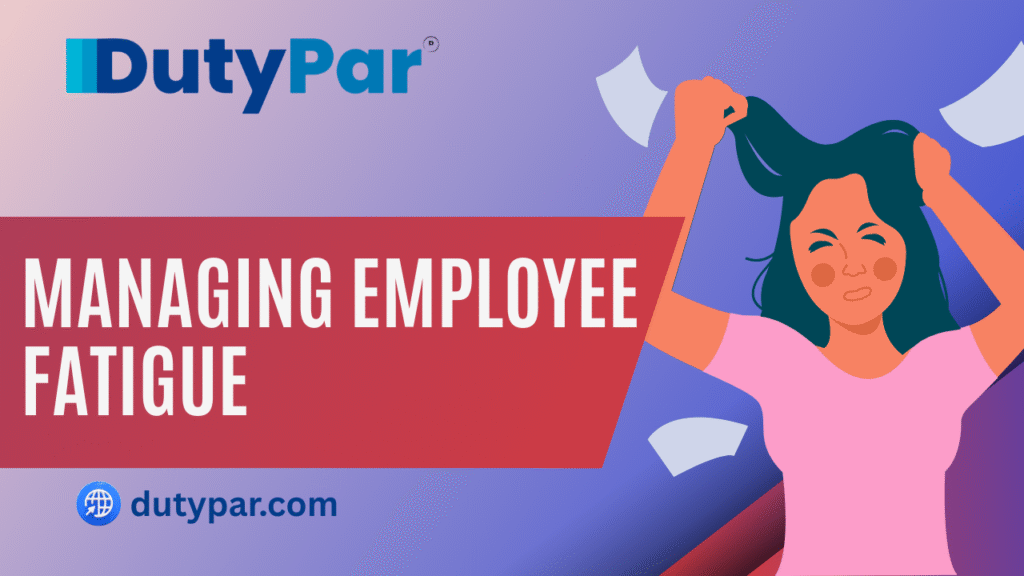
Table of contents
- What is Employee Fatigue?
- Why Employee Fatigue is a Serious Issue
- Common Causes of Employee Fatigue
- Signs of Employee Fatigue
- How to Manage Employee Fatigue
- Table: Central Strategies to Manage Employee Fatigue
- Role of Employers in Reducing Fatigue
- Role of Employees in Managing Fatigue
- Long-Term Benefits of Managing Employee Fatigue
- DutyPar and Employee Fatigue Management
- Conclusion
Labour is an intrinsic part of humanity, and as pressures at work increase, it becomes increasingly difficult to overcome employee fatigue. But fatigue is not just tiredness. It reduces focus, productivity, and in the long-term, workers’ health. And, if workers fatigue goes unnoticed there are implications for not just employees, but for organizations, too.
What is Employee Fatigue?
Employee stress is a physical or mental state of exhaustion caused by long work hours, pressure, or lack of rest. Fatigue decreases alertness and slows performance. Employees who are tired due to fatigue can make mistakes, lose motivation and perform poorly to the point of health issues.
The key point of difference between short-term tiredness and employee fatigue is duration – fatigue builds from one poor performance to the next or one poor period of sleep to the next. Fatigue can develop from a lack of or poor sleep, repetitive tasks, an employee’s heavy workload, and sometimes emotional stress as well. Organizations should be serious about employee stress because it directly or indirectly affects safety and operational or organizational outcomes.

Why Employee Fatigue is a Serious Issue
Failing to recognize the effects of employee fatigue can be seriously detrimental. Productivity suffers, absenteeism increases, and employees, suffering from burnout, leave companies. Fatigue is associated with an increased likelihood of accidents in fields such as manufacturing, transportation, and healthcare.
For employees, fatigue can lead to migraines, anxiety, and weakened immunity. For employers, fatigue translates into mistakes, delays, and increased turnover. When a workplace disregards employee fatigue, they leave time and money on the table.
Common Causes of Employee Fatigue
Several factors contribute to employee fatigue. The most common are:
- Long Working Hours: Extended shifts and overtime reduce rest time.
- Poor Sleep Patterns: Stress, night shifts, or irregular schedules disrupt sleep.
- Monotonous Tasks: Repetitive work lowers alertness and energy.
- High Stress: Constant pressure from deadlines or targets drains mental energy.
- Lack of Breaks: Continuous work without pauses increases exhaustion.
- Workplace Environment: Noise, poor lighting, or uncomfortable seating contribute to fatigue.
Signs of Employee Fatigue
Recognizing fatigue early is key to managing it. Some signs include:
- Frequent yawning or dozing at work
- Slow reaction times
- More mistakes or missed tasks
- Irritability or lack of focus
- Complaints of headaches or body pain
- Low motivation and reduced interest in tasks

How to Manage Employee Fatigue
Reducing employee stress involves both organizational and personal actions. Organizations need to create healthy policies; employees need to engage in self-care. When an organization and its employees work together, they can do a better job of reducing fatigue and have a greater positive impact on energy in the workplace.
1. Improve Work Schedules
Rotating shifts, long hours, and overtime all contribute to employee fatigue. Employers must create balanced schedules when possible. For example, allowing adequate time for rest between shifts is as essential as limiting the number of consecutive night shifts.
2. Support Regular Breaks
Regular breaks during work hours helps to refresh mental energy. A five-minute break taken every hour helps to moderate fatigue strain. Even a simple change of movement such as walking, stretching, or relaxing can build-up levels of fatigue.
3. Improve Workplace Environment
Providing a workspace that is conducive to the employee’s well-being will help reduce employee fatigue. Some aspects to consider are appropriate environmental conditions such as light, seating, and air quality (ventilation). An example would be providing employees “quiet rooms” in open offices spaces to help support focused work.
4. Promote Healthy Lifestyle Choices
Support for getting adequate sleep, eating the right amount of calories, staying hydrated, and getting regular exercise can support the body’s energy levels. Employers should try to support or seek employee wellness programs so employees learn how to recognize and effective use supports for stress management to help improve mental/emotional energy that leads to reduced future levels of employee stress over time.
5. Use Technology Smartly
Employers can use attendance apps, workload trackers, and employee heart rate monitors to spot early warning signs of fatigue. Employers can plan employee schedules and workloads more appropriately using these technologies.
Table: Central Strategies to Manage Employee Fatigue
| Strategy | Benefit |
|---|---|
| Balanced work schedules | Prevents long-term exhaustion |
| Regular short breaks | Boosts focus and productivity |
| Healthy workplace design | Reduces physical and mental strain |
| Stress management programs | Improves mental well-being |
| Smart use of technology | Tracks fatigue and adjusts workloads |

Role of Employers in Reducing Fatigue
Employers have an important part to play in terms of employee fatigue. They need to take fatigue seriously by acknowledging it exists as a risk in the workplace, instead of as simply a personal problem. Leaders also need to be able to talk about it freely regarding policies regarding fair working hours, safe working environments and supporting employee wellness.
Another important factor for employers is to train their managers correctly on recognizing fatigue. For example, if employees are struggling to stay alert, managers should be finding ways to encourage breaks, flexible schedules, and rotation of tasks. By beginning to acknowledge fatigue, employers proactively instill confidence in their employees and this helps to build a level of loyalty.
Role of Employees in Managing Fatigue
Employees have responsibilities, as well. Getting good sleep, being alert to caffeine consumption and maintaining physical activity to combat fatigue, and finding relaxation strategies including meditation can all help to combat stress.
However, the most important thing that employees must do is talk to managers. If work schedules or stress levels seem high and don’t seem to be a good fit, discussion (open communication) opens the channel to identifying ways to remedy the situation. The silence surrounding employee stresscan also be complemented by a well-developed culture of open communication, which minimizes the chances of employees suffering in silence.
Long-Term Benefits of Managing Employee Fatigue
Addressing employee fatigue is more than rest. It generates long-term gains for both employees and the organization. For employees, better health, better mood, and better motivation will come from it. For organizations, this means fewer mistakes by employees, improved retention, and superior performance.
In fact, studies show companies with wellness policies, report greater levels of productivity. Therefore, minimizing employee stress is tantamount to both an employee health imperative and a business initiative.
DutyPar and Employee Fatigue Management
DutyPar, a smart attendance and workforce management platform, also helps manage employee fatigue. By tracking attendance with accuracy, DutyPar ensures fair schedules and prevents overwork.
- Smart Scheduling: DutyPar helps managers assign shifts fairly.
- Attendance Accuracy: It eliminates proxy attendance, ensuring real working hours are recorded.
- Data Insights: DutyPar provides reports to spot patterns of overwork and absenteeism.
- Transparency: Both employees and employers get a clear picture of workloads.
Conclusion
Employee fatigue is a genuine challenge in today’s fast-paced work culture. Employee fatigue decreases productivity, can cause stress, impacts health, and creates safety hazards. Employee fatigue can be mitigated with proper planning and strategies. Changes to schedules and work environments, stress management programs and the use of technology can help manage employee fatigue.
The responsibility is really joint action between an employer and employee. When there is a focus on rest and well-being in the workplace, it is possible to build a close-knit team. Tools such as DutyPar are an additional way of managing employee stress and providing fairness in scheduling and workload management.